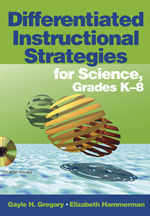Differentiated Instructional Strategies for Science, Grades K-8
- Gayle H. Gregory - Educational Consultant, Burlington, Ontario
- Elizabeth Hammerman - Educational Consultant, Texas
"This book addresses a real area of need and contains an abundant set of strategies."
—Susan Koba, Educational Consultant
"This is an excellent sourcebook for science teachers who are looking for strategies to engage diverse learners."
—Phyllis Milne, Associate Director of School Administration
York County School Division, Yorktown, VA
Help all your students "do" science confidently and successfully!
Preparing students to understand and adapt to the rapid pace of scientific and technological changes is an important educational priority. Using proven strategies for differentiating instruction, authors Gayle H. Gregory and Elizabeth Hammerman provide a blueprint for strengthening science instruction and accommodating students' individual learning styles.
This educator-friendly resource is aligned with national science curriculum standards and includes:
- Grade-appropriate sample lessons and strategies for inquiry-based, problem-based, and cooperative learning
- Guidelines for creating performance tasks that have real-world applications
- Methods for using data-based assessment before, during, and after learning
- A collection of templates, planners, checklists, and graphic organizers
- A CD-ROM with reproducibles for classroom instruction
Rich in content and tools, Differential Instructional Strategies for Science, Grades K–8 is the perfect resource to help elementary and middle school students become more creative and engaged thinkers and inquirers.
"Teachers will find techniques to apply in the classroom immediately. The examples are user friendly and easy to understand. There is little doubt that using these strategies will enhance any science classroom."
"This book addresses a real area of need and contains an abundant set of strategies."
"This is an excellent sourcebook for science teachers who are looking for strategies to engage diverse learners. The reader can look for a specific topic and find not only support for the strategies but also specific examples of the teaching tools. The charts, strategies, graphics, and rubrics are reader-friendly!"
"The book contains a lot of information about national science standards and multiple learning styles, plus good sample units in science and good suggestions for Web sites. The authors are great science teachers who believe wholly in engaging students in the wonder of the natural world."
"The book provides very useful information for implementing differentiated instruction. Its research base plus concrete and useable examples mixes the theory with the practical. Teachers will find this book valuable."
“An impressively comprehensive collection of student-centered, research-based classroom practices in one slim, well-organized volume. This book would be a valuable resource to teachers in any setting. Preservice teachers are likely to keep it long after the class has ended to revisit management topics such as organizing a science notebook and creating cooperative groups, as well as to use or adapt the science-interest inventory and organizers for explaining and creating meaning. Districts will benefit from the book’s focus on process skills and pedagogy as well as the integration of 21st-century literacy standards with the science content standards. Science specialists, gifted and talented resource teachers, and special educators will all appreciate the book’s approach to high expectations for students, thinking and problem solving, and authentic assessment. The book would also be an excellent book study as part of the development of professional learning communities.”
Sample Materials & Chapters
Part I: Effective Science Education & Chapter 1: Creating a Climate for Differen




